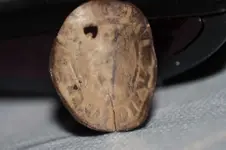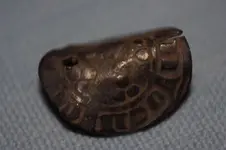Iron Patch
Platinum Member
- Joined
- Sep 28, 2007
- Messages
- 19,257
- Reaction score
- 8,765
- Golden Thread
- 3
- Location
- Dirtyville
- 🥇 Banner finds
- 3
- Detector(s) used
- Deus
- Primary Interest:
- All Treasure Hunting
...and I was about twenty feet away when it was found. On what seems to be a rare occasion the last few years the three of us who hunt together (or used to) got out with the addition of a guest from out of town. Of course he was the one who dug the coin  ... and I had been so close so many times! I'm not sure how long it took for my other buds to realize what he had but I definitely knew at first glance he hit one very old English silver. Unfortunately as you can see it has a 'slight' bend in it.
... and I had been so close so many times! I'm not sure how long it took for my other buds to realize what he had but I definitely knew at first glance he hit one very old English silver. Unfortunately as you can see it has a 'slight' bend in it.
Ok UK guys, I believe it's an early silver penny but to me these all look the same in the Spink. Two questions if you could.... 1) Do you think with the limited amount in these pictures I can ID it? 2) If question one is a yes, or maybe, is there any ones thing that I can look for to determine monarch? I thought I'd post it because I only have access to the picture and it makes more sense to let the guys who know have a look. My friend thinks 1200s/1300s. Thanks! (I believe it's about sixpense in size)
 ... and I had been so close so many times! I'm not sure how long it took for my other buds to realize what he had but I definitely knew at first glance he hit one very old English silver. Unfortunately as you can see it has a 'slight' bend in it.
... and I had been so close so many times! I'm not sure how long it took for my other buds to realize what he had but I definitely knew at first glance he hit one very old English silver. Unfortunately as you can see it has a 'slight' bend in it. Ok UK guys, I believe it's an early silver penny but to me these all look the same in the Spink. Two questions if you could.... 1) Do you think with the limited amount in these pictures I can ID it? 2) If question one is a yes, or maybe, is there any ones thing that I can look for to determine monarch? I thought I'd post it because I only have access to the picture and it makes more sense to let the guys who know have a look. My friend thinks 1200s/1300s. Thanks! (I believe it's about sixpense in size)








 that has to be the oldest coin ever dug in the States! it makes me really wonder how the hell it came to be at a colonial site.
that has to be the oldest coin ever dug in the States! it makes me really wonder how the hell it came to be at a colonial site.  that coin was old when Columbus discovered America! outstanding!
that coin was old when Columbus discovered America! outstanding!
